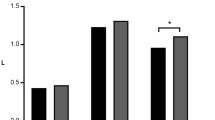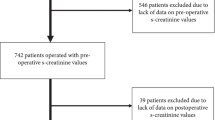Abstract
Background
We aimed to determine the prevalence, risk factors, and outcomes of acute kidney injury (AKI) within an ERAS program for colorectal surgery (CRS).
Methods
This is a retrospective case–control study conducted from March 2016 to September 2018 at a single tertiary hospital in Singapore. All adult patients requiring CRS within our ERAS program were considered eligible. Exclusions were stage 5 chronic kidney disease or patients requiring a synchronous liver resection. The primary outcome was AKI as defined by the Kidney Disease Improving Global Outcomes (KDIGO) Acute Kidney Injury Work Group. Secondary outcomes included mortality, major complications, and hospital length of stay. Patient, surgical, and anaesthesia-related data were analysed to determine factors associated with AKI.
Results
A total of 575 patients were eligible for the study. Twenty patients were excluded from the study leaving 555 patients for analysis. Mean age was 67.8 (SD 11.4) years. Seventy-four patients met the criteria for AKI (13.4%: stage 1—11.2%, stage 2—2.0%, stage 3—0.2%). One patient required renal replacement therapy (RRT). Patients with AKI had a longer length of stay (median [IQR], 11.0 [5.0–17.0] days vs 6.0 [4.0–8.0] days; P < .001), more major complications (OR, 6.55; 95% CI, 3.00–14.35, P < .001), and a trend towards higher mortality at one year (OR, 1.44; 95% CI 0.48–4.30; p = 0.511. After multivariable regression analysis, factors associated with AKI were preoperative creatinine (OR, 1.01 per 10 µmol/l; 95% CI, 1.03–1.22; P = 0.01), robotic surgery vs open surgery (OR, 0.15; 95% CI, 0.06–0.39; P < 0.001), anaesthesia duration (OR, 1.38 per hour; 95% CI, 1.22–1.55; P < 0.001), and major complications (OR, 5.55; 95% CI, 2.63–11.70; P < 0.001).
Conclusions
Within the present cohort, the implementation of an ERAS program for CRS was associated with a low prevalence of moderate to severe AKI despite a balanced intravenous fluid regimen. Patients having open surgery, longer procedures, and major complications are at increased risk of AKI.
Similar content being viewed by others
References
Gameiro J, Fonseca JA, Neves M et al (2018) Acute kidney injury in major abdominal surgery: incidence, risk factors, pathogenesis and outcomes. Ann Intensive Care 8:22–24
KDIGO Clinical Practice Guideline for Acute Kidney Injury, Kidney International Supplements (2012) Kidney Disease: Improving Global Outcomes (KDIGO) Working Group. Kidney Int Suppl 2:8–12
Marcotte JH, Patel K, Desai R et al (2018) Acute kidney injury following implementation of an enhanced recovery after surgery (ERAS) protocol in colorectal surgery. Int J Colorectal Dis 33:1259–1267
Koerner CP, Lopez-Aguiar AG, Zaidi M, Speegle S, Balch G (2019) Caution: increased acute kidney injury in enhanced recovery after surgery (ERAS) protocols. Am Surg 85:156–161
Shim JW, Kim KR, Jung Y et al (2020) Role of intraoperative oliguria in risk stratification for postoperative acute kidney injury in patients undergoing colorectal surgery with an enhanced recovery protocol: a propensity score matching analysis. PLoS ONE 15:e0231447
Wiener JGD, Goss L, Wahl TS et al (2020) The association of enhanced recovery pathway and acute kidney injury in patients undergoing colorectal surgery. Dis Colon Rectum 63:233–241
Grass F, Lovely JK, Crippa J et al (2019) Early acute kidney injury within an established enhanced recovery pathway: uncommon and transitory. World J Surg 43:1207–1215
Hassinger TE, Turrentine FE, Thiele RH et al (2018) Acute kidney injury in the age of enhanced recovery protocols. Dis Colon Rectum 61:946–954
Long TE, Helgason D, Helgadottir S et al (2016) Acute kidney injury after abdominal surgery: incidence, risk factors, and outcome. Anesth Analg 122:1912–1920
Myles PS, Bellomo R, Corcoran T et al (2018) Restrictive versus liberal fluid therapy for major abdominal surgery. N Engl J Med 378:2263–2274
Feldheiser A, Aziz O, Baldini G et al (2016) Enhanced recovery after surgery (ERAS) for gastrointestinal surgery, part 2: consensus statement for anaesthesia practice. Acta Anaesthesiol Scand 60:289–334
Gustafsson UO, Scott MJ, Hubner M et al (2019) Guidelines for perioperative care in elective colorectal surgery: enhanced recovery after surgery (ERAS((R))) society recommendations: 2018. World J Surg 43:659–695
von Elm E, Altman DG, Egger M et al (2007) The strengthening the reporting of observational studies in epidemiology (STROBE) statement: guidelines for reporting observational studies. Epidemiology 18:800–804
Encare ERAS Interactive Audit System, https://www.encare.net/healthcare-professionals/products-and-services/eras-interactive-audit-system-eias, 2019.
MDRD for Adults (Conventional Units), National Institute for Diabetes and Digestive and Kidney Diseases Online Calculator: https://www.niddk.nih.gov/health-information/professionals/clinical-tools-patient-management/kidney-disease/laboratory-evaluation/glomerular-filtration-rate-calculators/mdrd-adults-si-units. Accessed 15 Dec 2018
Shiba A, Uchino S, Fujii T et al (2018) Association between intraoperative oliguria and acute kidney injury after major noncardiac surgery. Anesth Analg 127:1229–1235
O’Connor ME, Kirwan CJ, Pearse RM et al (2016) Incidence and associations of acute kidney injury after major abdominal surgery. Intensive Care Med 42:521–530
Horres CR, Adam MA, Sun Z et al (2017) Enhanced recovery protocols for colorectal surgery and postoperative renal function: a retrospective review. Perioper Med (Lond) 6:13
Kork F, Balzer F, Spies CD et al (2015) Minor postoperative increases of creatinine are associated with higher mortality and longer hospital length of stay in surgical patients. Anesthesiology 123:1301–1311
Fortrie G, de Geus HRH, Betjes MGH (2019) The aftermath of acute kidney injury: a narrative review of long-term mortality and renal function. Crit Care 23:24
Lilot M, Ehrenfeld JM, Lee C et al (2015) Variability in practice and factors predictive of total crystalloid administration during abdominal surgery: retrospective two-centre analysis. Br J Anaesth 114:767–776
Hobson C, Ruchi R, Bihorac A (2017) Perioperative acute kidney injury: risk factors and predictive strategies. Crit Care Clin 33:379–396
Elias KM, Stone AB, McGinigle K et al (2019) The reporting on eras compliance, outcomes, and elements research (RECOvER) checklist: a joint statement by the ERAS((R)) and ERAS((R)) USA societies. World J Surg 43:1–8
Wesselink EM, Kappen TH, Torn HM et al (2018) Intraoperative hypotension and the risk of postoperative adverse outcomes: a systematic review. Br J Anaesth 121:706–721
Goren O, Matot I (2015) Perioperative acute kidney injury. Br J Anaesth 115(Suppl 2):ii3-14
Giglio M, Dalfino L, Puntillo F et al (2019) Hemodynamic goal-directed therapy and postoperative kidney injury: an updated meta-analysis with trial sequential analysis. Crit Care 23:232
Futier E, Lefrant JY, Guinot PG et al (2017) Effect of individualized vs standard blood pressure management strategies on postoperative organ dysfunction among high-risk patients undergoing major surgery: a randomized clinical trial. JAMA 318:1346–1357
Vittinghoff E, McCulloch CE (2007) Relaxing the rule of ten events per variable in logistic and Cox regression. Am J Epidemiol 165:710–718
Author information
Authors and Affiliations
Corresponding author
Ethics declarations
Conflict of interest
P.A. Drakeford has received honoraria from Edwards Lifesciences, S. Tham: Nil disclosures, J. Kwek: Nil disclosures, V. Lim: Nil disclosures, C.J. Lim: Nil disclosures, K.Y. How has received honoraria from Edwards Lifesciences, Baxter Healthcare, MSD Pharma(Sing). O. Ljungqvist is Chairman of the ERAS Society, author of ERAS Guidelines, founder and owner of stock in Encare AB, and has received travel and speakers honoraria from Nutricia, Fresenius-Kabi, and Medtronic, and provided advice to Nutricia, Pharmacosmos, Enhanced Medical Nutrition.
Additional information
Publisher's Note
Springer Nature remains neutral with regard to jurisdictional claims in published maps and institutional affiliations.
Appendix 1
Appendix 1
See Table
9.
Rights and permissions
About this article
Cite this article
Drakeford, P.A., Tham, S.Q., Kwek, J.L. et al. Acute Kidney Injury within an Enhanced Recovery after Surgery (ERAS) Program for Colorectal Surgery. World J Surg 46, 19–33 (2022). https://doi.org/10.1007/s00268-021-06343-6
Accepted:
Published:
Issue Date:
DOI: https://doi.org/10.1007/s00268-021-06343-6




